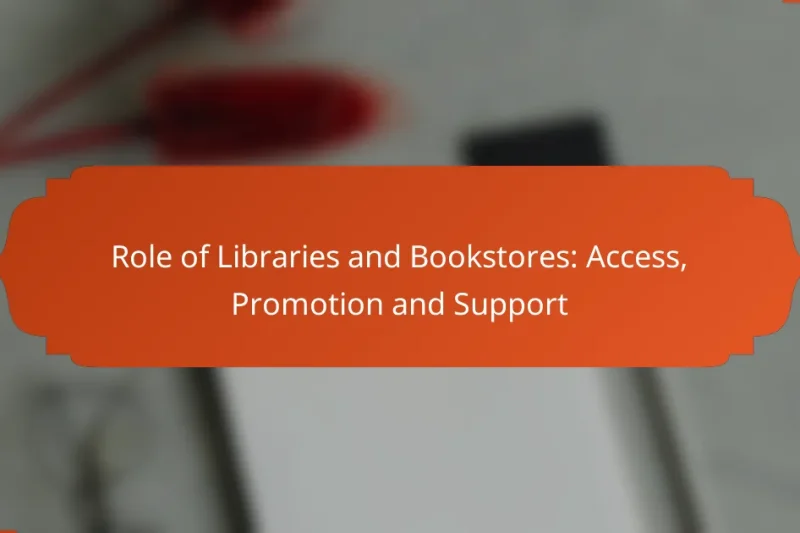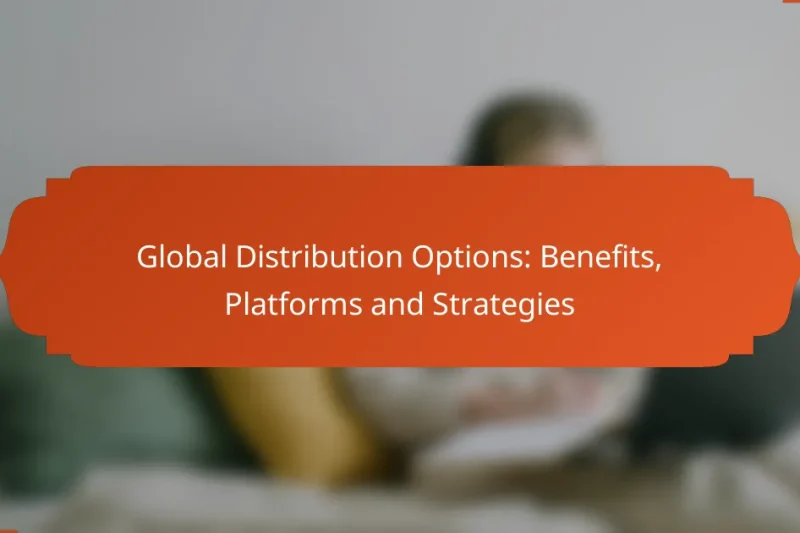Libraries and bookstores serve as vital resources for communities, enhancing access to literature and supporting local … Role of Libraries and Bookstores: Access, Promotion and SupportRead more
Distribution Channels for Self-Publishing
Self-publishing offers a variety of distribution channels that can significantly enhance an author’s visibility and sales potential. Platforms like Amazon Kindle Direct Publishing, Smashwords, and IngramSpark each provide unique benefits, making it crucial for authors to choose the right one based on their audience and goals. Understanding the associated costs and potential earnings is essential for maximizing profitability in the competitive self-publishing landscape.
Global Distribution Options: Benefits, Platforms and Strategies
Global distribution options present e-commerce businesses with the opportunity to expand their reach and boost sales … Global Distribution Options: Benefits, Platforms and StrategiesRead more
What are the best distribution channels for self-publishing in the US?
The best distribution channels for self-publishing in the US include platforms that maximize visibility and sales potential. Key options are Amazon Kindle Direct Publishing, Smashwords, IngramSpark, Kobo Writing Life, and Draft2Digital, each offering unique advantages for authors.
Amazon Kindle Direct Publishing
Amazon Kindle Direct Publishing (KDP) is one of the most popular self-publishing platforms, allowing authors to publish eBooks and paperbacks directly on Amazon. KDP offers a user-friendly interface and access to millions of readers, making it an attractive option for new authors.
Authors can set their own prices and earn royalties ranging from 35% to 70%, depending on the pricing strategy. It’s essential to consider Amazon’s exclusive programs, like Kindle Unlimited, which can boost visibility but require exclusivity.
Smashwords
Smashwords is a distribution platform that allows authors to publish eBooks and distribute them to various retailers, including Apple Books, Barnes & Noble, and Kobo. This platform is ideal for authors looking to reach a wider audience beyond Amazon.
Smashwords offers a straightforward publishing process and provides authors with a variety of pricing options. However, authors should be aware of the formatting requirements to ensure their eBooks meet the platform’s standards.
IngramSpark
IngramSpark is a powerful distribution channel for authors seeking to publish print books and eBooks. It connects authors to a vast network of bookstores and libraries, making it a strong choice for those looking to reach physical retail markets.
While IngramSpark has a setup fee, the potential for broader distribution can justify the cost. Authors should consider the importance of quality cover design and formatting to meet industry standards for print books.
Kobo Writing Life
Kobo Writing Life is a self-publishing platform that allows authors to publish eBooks and reach readers in over 190 countries. It is particularly popular in Canada and Europe, making it a good option for authors targeting international markets.
Authors can set their own prices and earn up to 70% royalties, similar to KDP. Kobo also offers promotional opportunities and marketing tools to help authors increase their visibility.
Draft2Digital
Draft2Digital is a user-friendly distribution service that helps authors publish eBooks and distribute them to multiple retailers, including Amazon, Apple Books, and Barnes & Noble. It simplifies the publishing process with easy formatting tools and a straightforward interface.
Authors benefit from a free service that takes a small percentage of royalties, making it a cost-effective choice. Draft2Digital also offers helpful resources, such as promotional tools and author support, which can enhance an author’s publishing experience.
How to choose the right distribution channel?
Choosing the right distribution channel for self-publishing involves understanding your audience, evaluating potential earnings, and assessing how widely your work can be distributed. Each channel has its unique advantages and drawbacks, making it essential to align your choice with your goals and target market.
Consider target audience
Your target audience plays a crucial role in selecting a distribution channel. Identify where your readers are most likely to purchase books—whether online, in bookstores, or through libraries. For instance, if your audience is primarily young adults, platforms like Amazon or social media-driven sales might be more effective.
Additionally, consider the genre of your work. Niche genres may benefit from specialized platforms that cater to specific reader interests, while mainstream genres might perform better on larger, more general platforms.
Evaluate royalty rates
Royalty rates can significantly impact your earnings from self-publishing. Different platforms offer varying rates, typically ranging from 35% to 70% of the sale price. For example, Amazon Kindle Direct Publishing offers 70% royalties for eBooks priced between $2.99 and $9.99, while other platforms may have lower rates.
When evaluating royalty rates, also consider any additional costs, such as distribution fees or marketing expenses. A higher royalty rate may not always equate to higher profits if the platform charges substantial fees.
Assess distribution reach
The distribution reach of a channel determines how many potential readers will have access to your work. Some platforms, like Amazon, have extensive global reach, while others may be limited to specific regions or formats. Assess whether your target audience is likely to use the platform you choose.
Additionally, consider whether the channel allows for both digital and print distribution. A platform that offers both can maximize your exposure and sales potential. Researching the reach of each option will help you make an informed decision that aligns with your distribution goals.
What are the costs associated with self-publishing distribution?
The costs associated with self-publishing distribution can vary significantly based on the chosen platforms and services. Key expenses include setup fees, commission rates, and print costs, each impacting overall profitability and pricing strategies.
Setup fees
Setup fees are initial costs charged by distribution platforms to publish your book. These fees can range from zero to several hundred dollars, depending on the service. For example, platforms like Amazon Kindle Direct Publishing (KDP) typically have no upfront fees, while others may charge a flat rate for setup.
When considering setup fees, evaluate what services are included. Some platforms offer additional features like marketing tools or formatting assistance, which can justify higher fees.
Commission rates
Commission rates are the percentage of sales that distribution platforms retain from your book sales. These rates usually range from 15% to 60%, depending on the platform and distribution method. For instance, Amazon KDP takes a 30% commission on eBooks priced under $2.99 and 65% for those priced higher.
Understanding commission structures is crucial for pricing your book effectively. Consider how different rates will affect your royalties and overall earnings, and choose platforms that align with your financial goals.
Print costs
Print costs refer to the expenses incurred when producing physical copies of your book. These costs can vary based on factors like page count, paper quality, and printing method. On-demand printing services typically charge per book, with prices often ranging from a few dollars to over ten dollars per copy.
When calculating print costs, factor in shipping and handling fees, especially if you plan to distribute copies directly to readers or retailers. It’s essential to set your retail price to cover these costs while remaining competitive in the market.
How do royalties work in self-publishing?
Royalties in self-publishing refer to the earnings an author receives from the sale of their books. These earnings are typically calculated as a percentage of the sales price and can vary based on the distribution channel used.
Percentage of sales
The percentage of sales that authors earn as royalties can differ significantly between platforms. For instance, many self-publishing platforms offer royalties ranging from 35% to 70% of the book’s sale price, depending on factors like pricing and distribution choices.
Authors should consider the trade-offs between higher royalty percentages and broader distribution. Platforms with lower royalties may provide access to larger markets, while those with higher rates might limit exposure.
Payment schedules
Payment schedules for self-publishing royalties can vary by platform, with common intervals being monthly, quarterly, or biannually. Authors should review the specific payment terms of their chosen distribution channels to understand when they can expect to receive their earnings.
It’s important to note that some platforms may have minimum payout thresholds, meaning authors must earn a certain amount before receiving payment. Keeping track of sales and understanding these schedules can help authors manage their finances effectively.
What are the advantages of using multiple distribution channels?
Using multiple distribution channels allows self-published authors to maximize their visibility and sales potential. By diversifying where and how their work is available, authors can reach different segments of the market and create more opportunities for revenue.
Wider audience reach
Multiple distribution channels significantly enhance an author’s ability to reach a broader audience. By utilizing platforms such as Amazon, Barnes & Noble, and independent bookstores, authors can tap into various reader demographics. Each channel attracts different types of readers, allowing authors to engage with niche markets and mainstream audiences alike.
For instance, while Amazon may dominate online sales, local bookstores can foster community connections and attract readers who prefer physical books. Authors should consider both online and offline channels to ensure they are not missing potential readers.
Diverse revenue streams
Employing various distribution channels can create multiple revenue streams for self-published authors. By selling through different platforms, authors can benefit from varying pricing strategies and promotional opportunities, which can lead to increased overall sales. For example, eBooks may sell well on Amazon, while print copies might perform better in local bookstores.
Authors should also explore subscription services or direct sales through their own websites. This approach not only diversifies income but also allows for greater control over pricing and customer relationships. However, it’s essential to monitor which channels yield the best returns and adjust strategies accordingly to optimize revenue.
What are the challenges of self-publishing distribution?
Self-publishing distribution presents several challenges, including market saturation, visibility, and the complexity of managing multiple platforms. Authors must navigate various distribution channels while ensuring their work reaches the right audience effectively.
Market Saturation
The self-publishing market is highly competitive, with thousands of new titles released daily. This saturation makes it difficult for individual authors to stand out and attract readers. To combat this, authors should focus on niche markets or unique selling propositions that differentiate their work.
Visibility and Marketing
Achieving visibility in a crowded marketplace requires strategic marketing efforts. Authors must invest time in building an online presence through social media, author websites, and email newsletters. Engaging with readers and utilizing platforms like Goodreads can enhance visibility and foster a loyal audience.
Managing Multiple Platforms
Self-publishing often involves distributing books across various platforms, such as Amazon Kindle, Apple Books, and Smashwords. Each platform has its own requirements and royalty structures, which can be overwhelming. Authors should consider using aggregation services to simplify distribution while maximizing reach.
Understanding Royalties
Royalties can vary significantly between platforms, typically ranging from 35% to 70% depending on pricing and distribution choices. Authors must carefully analyze these structures to determine the most profitable pricing strategies. Keeping track of earnings across multiple channels is essential for financial planning.
Quality Control
Ensuring high-quality content is crucial in self-publishing. Authors should invest in professional editing and cover design to enhance their book’s appeal. Poorly edited or designed books can lead to negative reviews and reduced sales, making quality control a top priority.

